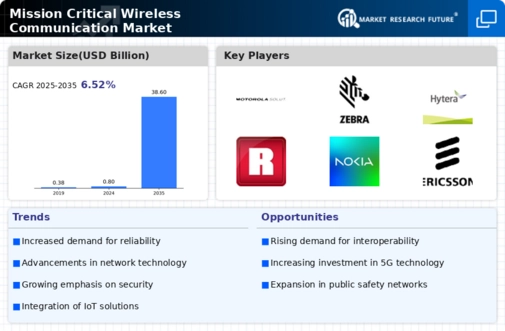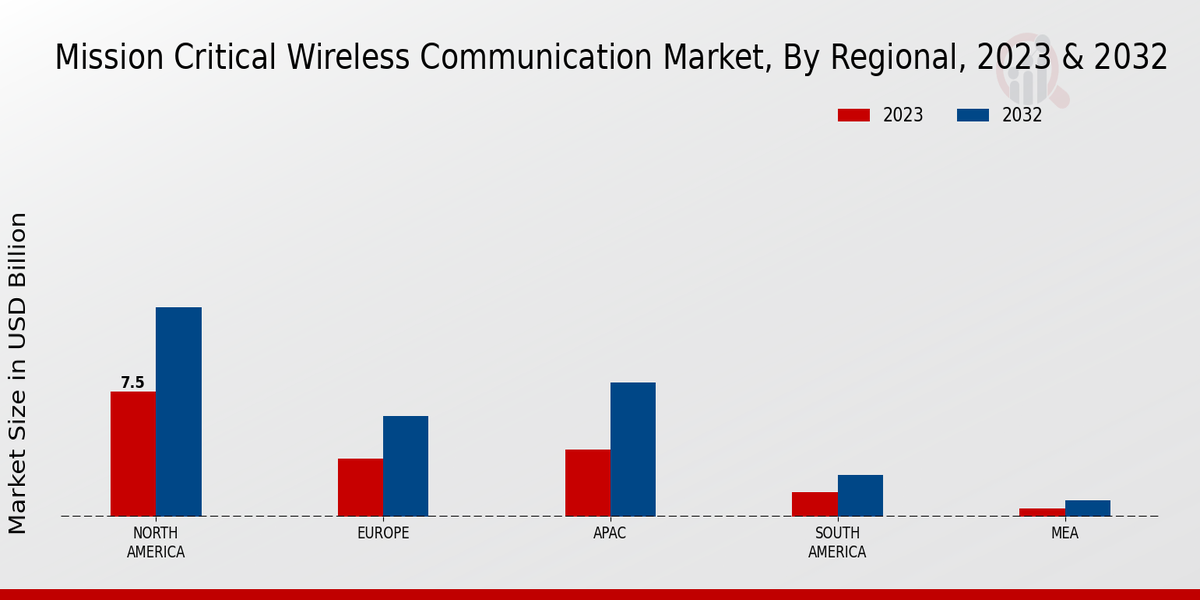Rising Security Concerns
Rising security concerns across various sectors contribute to the growth of the Global Mission Critical Wireless Communication Market Industry. As cyber threats and data breaches become increasingly prevalent, organizations prioritize secure communication channels for mission-critical operations. The demand for encrypted communication solutions and secure network infrastructures is on the rise, prompting investments in advanced wireless technologies. This heightened focus on security not only protects sensitive information but also enhances the overall reliability of communication systems. Consequently, the market is poised for significant growth, driven by the need for secure and resilient communication solutions.
Market Growth Projections
The Global Mission Critical Wireless Communication Market Industry is projected to experience robust growth, with estimates indicating a rise from 0.8 USD Billion in 2024 to 38.6 USD Billion by 2035. This remarkable growth trajectory suggests a compound annual growth rate of 42.26% from 2025 to 2035, highlighting the increasing reliance on wireless communication systems across various sectors. The market's expansion is driven by factors such as technological advancements, government initiatives, and rising security concerns, which collectively contribute to the demand for reliable and secure communication solutions.
Government Initiatives and Funding
Government initiatives and funding significantly influence the Global Mission Critical Wireless Communication Market Industry. Various governments worldwide are investing in upgrading communication infrastructure to enhance public safety and emergency response capabilities. For example, initiatives aimed at improving communication networks for first responders are gaining traction, leading to increased funding for wireless communication projects. This proactive approach not only bolsters the market but also ensures that critical services remain operational during emergencies. The anticipated growth in this sector is further supported by the projected compound annual growth rate of 42.26% from 2025 to 2035, reflecting the urgency of these initiatives.
Integration of AI and Data Analytics
The integration of artificial intelligence (AI) and data analytics into communication systems is transforming the Global Mission Critical Wireless Communication Market Industry. AI-driven solutions enhance decision-making processes, optimize network performance, and improve incident response times. By leveraging data analytics, organizations can gain valuable insights into communication patterns and system performance, enabling proactive measures to enhance reliability. This trend is particularly relevant in sectors such as public safety and transportation, where timely and accurate communication is critical. As organizations increasingly adopt AI and data analytics, the market is expected to expand significantly, reflecting the growing importance of these technologies.
Increasing Demand for Reliable Communication
The Global Mission Critical Wireless Communication Market Industry experiences a surge in demand for reliable communication systems across various sectors, including public safety, transportation, and utilities. As organizations increasingly rely on wireless communication for mission-critical operations, the need for robust and dependable networks becomes paramount. For instance, first responders require uninterrupted communication during emergencies, which drives investments in advanced wireless technologies. This trend is reflected in the market's projected growth, with an estimated value of 0.8 USD Billion in 2024, indicating a strong foundation for future expansion.
Technological Advancements in Wireless Solutions
Technological advancements play a pivotal role in shaping the Global Mission Critical Wireless Communication Market Industry. Innovations such as 5G technology, Internet of Things (IoT), and edge computing enhance the capabilities of wireless communication systems. These advancements enable faster data transmission, improved coverage, and enhanced security features, which are crucial for mission-critical applications. As organizations adopt these technologies, the market is expected to witness substantial growth, with projections indicating a remarkable increase to 38.6 USD Billion by 2035. This growth trajectory underscores the importance of staying abreast of technological developments to maintain competitive advantages.






















Leave a Comment